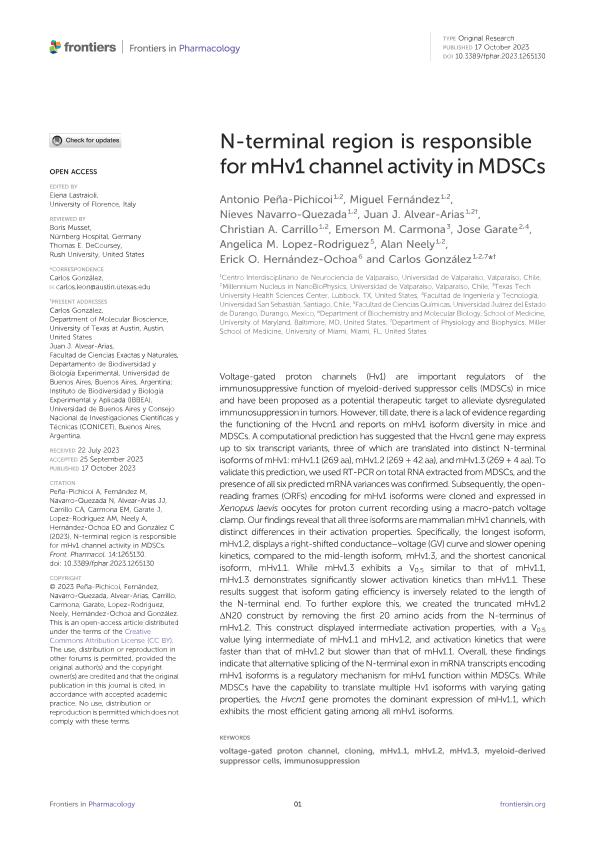Mostrar el registro sencillo del ítem
dc.contributor.author
Peña Pichicoi, Antonio
dc.contributor.author
Fernández, Miguel
dc.contributor.author
Navarro Quezada, Nieves
dc.contributor.author
Alvear Arias, Juan José

dc.contributor.author
Carrillo, Christian A.
dc.contributor.author
Carmona, Emerson M.
dc.contributor.author
Gárate, José Antonio

dc.contributor.author
Lopez Rodriguez, Angelica M.
dc.contributor.author
Neely, Alan
dc.contributor.author
Hernández Ochoa, Erick O.
dc.contributor.author
González, Carlos
dc.date.available
2024-02-26T13:47:33Z
dc.date.issued
2023-10
dc.identifier.citation
Peña Pichicoi, Antonio; Fernández, Miguel; Navarro Quezada, Nieves; Alvear Arias, Juan José; Carrillo, Christian A.; et al.; N-terminal region is responsible for mHv1 channel activity in MDSCs; Frontiers Media; Frontiers in Pharmacology; 14; 1265130; 10-2023; 1-14
dc.identifier.uri
http://hdl.handle.net/11336/228408
dc.description.abstract
Voltage-gated proton channels (Hv1) are important regulators of the immunosuppressive function of myeloid-derived suppressor cells (MDSCs) in mice and have been proposed as a potential therapeutic target to alleviate dysregulated immunosuppression in tumors. However, till date, there is a lack of evidence regarding the functioning of the Hvcn1 and reports on mHv1 isoform diversity in mice and MDSCs. A computational prediction has suggested that the Hvcn1 gene may express up to six transcript variants, three of which are translated into distinct N-terminal isoforms of mHv1: mHv1.1 (269 aa), mHv1.2 (269 + 42 aa), and mHv1.3 (269 + 4 aa). To validate this prediction, we used RT-PCR on total RNA extracted from MDSCs, and the presence of all six predicted mRNA variances was confirmed. Subsequently, the open-reading frames (ORFs) encoding for mHv1 isoforms were cloned and expressed in Xenopus laevis oocytes for proton current recording using a macro-patch voltage clamp. Our findings reveal that all three isoforms are mammalian mHv1 channels, with distinct differences in their activation properties. Specifically, the longest isoform, mHv1.2, displays a right-shifted conductance–voltage (GV) curve and slower opening kinetics, compared to the mid-length isoform, mHv1.3, and the shortest canonical isoform, mHv1.1. While mHv1.3 exhibits a V0.5 similar to that of mHv1.1, mHv1.3 demonstrates significantly slower activation kinetics than mHv1.1. These results suggest that isoform gating efficiency is inversely related to the length of the N-terminal end. To further explore this, we created the truncated mHv1.2 ΔN20 construct by removing the first 20 amino acids from the N-terminus of mHv1.2. This construct displayed intermediate activation properties, with a V0.5 value lying intermediate of mHv1.1 and mHv1.2, and activation kinetics that were faster than that of mHv1.2 but slower than that of mHv1.1. Overall, these findings indicate that alternative splicing of the N-terminal exon in mRNA transcripts encoding mHv1 isoforms is a regulatory mechanism for mHv1 function within MDSCs. While MDSCs have the capability to translate multiple Hv1 isoforms with varying gating properties, the Hvcn1 gene promotes the dominant expression of mHv1.1, which exhibits the most efficient gating among all mHv1 isoforms.
dc.format
application/pdf
dc.language.iso
eng
dc.publisher
Frontiers Media

dc.rights
info:eu-repo/semantics/openAccess
dc.rights.uri
https://creativecommons.org/licenses/by/2.5/ar/
dc.subject
CLONING
dc.subject
IMMUNOSUPPRESSION
dc.subject
MHV1.1
dc.subject
MHV1.2
dc.subject
MHV1.3
dc.subject
MYELOID-DERIVED SUPPRESSOR CELLS
dc.subject
VOLTAGE-GATED PROTON CHANNEL
dc.subject.classification
Biofísica

dc.subject.classification
Ciencias Biológicas

dc.subject.classification
CIENCIAS NATURALES Y EXACTAS

dc.title
N-terminal region is responsible for mHv1 channel activity in MDSCs
dc.type
info:eu-repo/semantics/article
dc.type
info:ar-repo/semantics/artículo
dc.type
info:eu-repo/semantics/publishedVersion
dc.date.updated
2024-02-22T11:06:58Z
dc.identifier.eissn
1663-9812
dc.journal.volume
14
dc.journal.number
1265130
dc.journal.pagination
1-14
dc.journal.pais
Suiza

dc.journal.ciudad
Lausana
dc.description.fil
Fil: Peña Pichicoi, Antonio. Universidad de Valparaíso; Chile
dc.description.fil
Fil: Fernández, Miguel. Universidad de Valparaíso; Chile
dc.description.fil
Fil: Navarro Quezada, Nieves. Universidad de Valparaíso; Chile
dc.description.fil
Fil: Alvear Arias, Juan José. Universidad de Valparaíso; Chile. Consejo Nacional de Investigaciones Científicas y Técnicas. Oficina de Coordinación Administrativa Ciudad Universitaria. Instituto de Biodiversidad y Biología Experimental y Aplicada. Universidad de Buenos Aires. Facultad de Ciencias Exactas y Naturales. Instituto de Biodiversidad y Biología Experimental y Aplicada; Argentina
dc.description.fil
Fil: Carrillo, Christian A.. Universidad de Valparaíso; Chile
dc.description.fil
Fil: Carmona, Emerson M.. Texas Tech University Health Sciences Center; Estados Unidos
dc.description.fil
Fil: Gárate, José Antonio. Universidad de Valparaíso; Chile. Universidad San Sebastián; Chile
dc.description.fil
Fil: Lopez Rodriguez, Angelica M.. Universidad Juárez del Estado de Durango; México
dc.description.fil
Fil: Neely, Alan. Universidad de Valparaíso; Chile
dc.description.fil
Fil: Hernández Ochoa, Erick O.. University of Maryland; Estados Unidos
dc.description.fil
Fil: González, Carlos. Universidad de Valparaíso; Chile. University of Miami; Estados Unidos
dc.journal.title
Frontiers in Pharmacology
dc.relation.alternativeid
info:eu-repo/semantics/altIdentifier/url/https://www.frontiersin.org/journals/pharmacology/articles/10.3389/fphar.2023.1265130/full
dc.relation.alternativeid
info:eu-repo/semantics/altIdentifier/doi/https://doi.org/10.3389/fphar.2023.1265130
Archivos asociados
